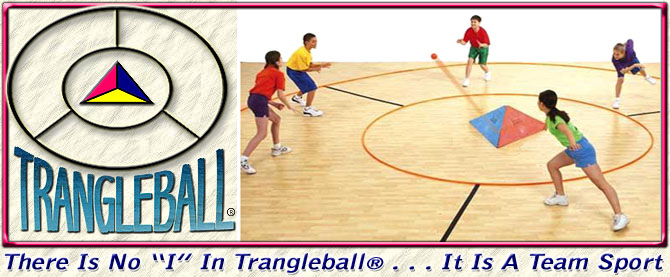|
All this – the refinements to the components, the increasing variety of people who play it and environments in which it gets played, and the development of new variations (see the activity guide), are crucial to the invention gaining acceptance and recognition as something that could be classified as an “official” sport. But my interest continues to be not so much in the sport itself, but in the playfulness, creativity, and fun generated by Mark Miller’s invention.
The central component is the pyramid. Because there are three faces, you naturally want to play something that involves three people or teams. Then there are the faces of the pyramid, which are angled so that if you stand in the right place and throw a ball, you can make it bounce right back to you. If you stand a little to the right or left of the face, you can make the ball go at an angle, and bounce it to a friend. If you stand at one of the points, you can bounce the ball at either side. It’s these properties, the physical properties of the structure and the angles, that lend themselves to the invention of yet more ways to play.
If you read the explanation of the process Miller went through in inventing the game, you can see how it was born, not out of an idea of how people should play or exercise, but out of play itself:
It was 3 am while waiting for the final band to finish their rehearsal in his music studio. He picked up a ball and threw it at the corner of the room where the 2 walls met the ceiling. After throwing it at what was seemingly the exact same spot, he noticed that each time the ball was rebounding in a different direction. Sometimes it went left, sometimes right, sometimes high or low.
It occurred to him that if he prototyped this corner and made it portable it would make a great product to help improve a ball player’s reflexes. The following day he sawed a 4×4 piece of plywood from corner to corner (As he says “the way my mom used to cut my sandwiches”). He then nailed 3 of the 4 triangles together resembling a corner. Instead of the ceiling, he now had a portable corner with 2 walls and a floor.
It worked just as well but he walked over to the prototype and flipped it over. He then realized that he, in fact, built a 3 sided pyramid.
He began to throw the ball at one of the panels but the ball rebounded right back to him. He thought to himself “this is fun but it will not improve ones reflexes as I had hoped”.
Then his “AH-HA!!!” moment came . . . . “If I ran 5 steps to the right of the panel that I was throwing the ball at an opponent would have to take 5 steps to the left to catch it.” The reflex was back in the concept but now it was a competitive game.
So it is like this. You take the fun, the fascination of the simplest of street games, like stoop-ball and maybe off-the-wall – games where you throw against something and then try to catch it, or to get someone else to catch it or miss it. Then you take the wall and turn it kind of inside out, until it’s something that you can walk around, that you can fit into the very middle of a game. And then, you see what happens. And then you see if you can make it happen just the way you want to make it happen. It is this invitation to discovery and invention that is so deeply embedded in the concept that underlies Trangleball’s success as sports equipment. For me, for my purposes, given my message, Trangleball embodies what I want to see happen in the gyms and on the beaches of the known universe – play, creativity, engagement, laughter.
|

